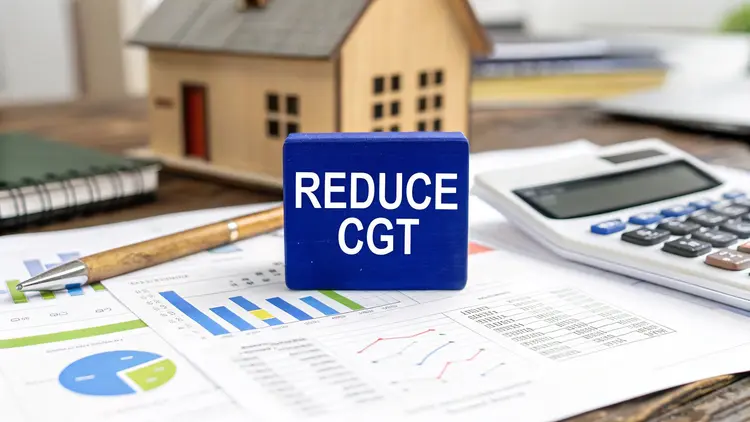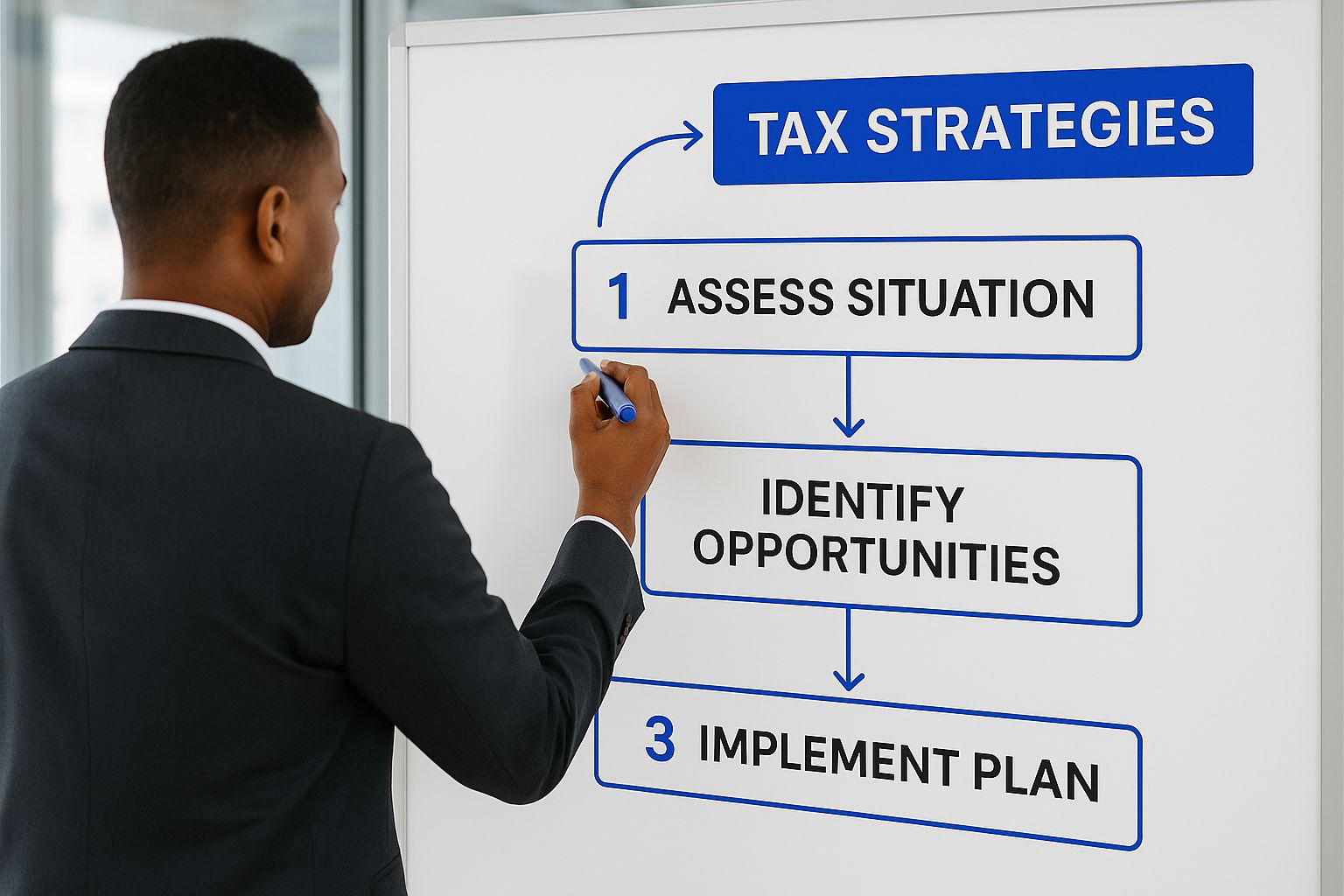
Before we get into the clever strategies for slashing your capital gains tax bill, it’s crucial to understand how the system actually works. Think of it less as a separate tax and more as a slice of your regular income tax. Any profit you make from selling an asset be it shares, an investment property, or even cryptocurrency gets tacked onto your yearly income and taxed at your personal rate.
Let’s get the fundamentals straight. When you sell or otherwise dispose of an asset, the Australian Taxation Office (ATO) calls this a ‘CGT event’. The profit you make from that event isn’t taxed in isolation. Instead, it’s added to your assessable income for the financial year.
So, how is that profit calculated? It’s simply the sale price minus what’s known as the ‘cost base’. Your cost base is the original purchase price plus all the other expenses you shelled out along the way things like stamp duty, legal fees, and brokerage costs. The bigger you can make your cost base (legally, of course), the smaller your taxable gain will be.
The ATO’s own website makes it clear: CGT affects most assets acquired after September 20, 1985.
Getting this calculation right is the absolute key to minimising what you owe. Because the gain is treated as income, it’s taxed at your marginal rate, which could be anywhere from 19% right up to 47% (including the Medicare levy).
Here’s the game-changer: If you hold onto an asset for more than 12 months, you can slash your taxable gain by 50%.
This 50% discount is arguably the most powerful tool in your arsenal. This simple rule is precisely why timing your sales and keeping meticulous records of every single cost is not just good practice, it’s essential.
When it comes to investing, a little patience can go a long way straight to your bottom line. I’ve seen it time and again: the single most effective strategy for most Australians to slash their capital gains tax is simply to hold onto an asset for more than 12 months before selling.
Get the timing right, and you unlock the 50% CGT discount. This is a game-changer. It means you can literally cut your taxable capital gain in half.
Imagine you’ve made a $20,000 profit on some shares. If you held them for over a year, you only need to add $10,000 of that gain to your assessable income for the year. That simple act of waiting can make a massive difference to your final tax bill.
Now, it’s crucial to understand that this powerful discount isn’t a free-for-all. Your eligibility comes down to how your investments are structured.
The difference between selling an asset at 11 months versus 13 months isn’t just a matter of two months on a calendar, it’s a fundamental shift in your tax outcome. Strategic patience directly translates into keeping more of your hard-earned profit.
Knowing these rules from the outset allows you to build a tax-smart investment strategy from day one. If you’re seriously thinking about how to reduce capital gains tax, timing your sale should be the first thing on your mind.
Let’s face it, not every investment is a winner. But even an asset that doesn’t perform as hoped can become a surprisingly useful part of your tax planning. The trick is knowing how to strategically use those capital losses to offset your gains, effectively turning a financial setback into a tax advantage.
A capital loss is what happens when you sell an asset for less than its cost base. While you can’t just deduct this loss from your regular salary, you can use it to wipe out a capital gain you’ve made in the same financial year. This is called “offsetting,” and it’s a cornerstone of smart CGT management.

Here’s where many people get tripped up, and it can be a costly mistake. The order in which you apply losses and discounts is absolutely critical.
You must apply your capital losses against your capital gains before you even think about applying the 50% CGT discount. Getting this sequence right ensures you maximise the benefit of both the loss and the discount.
Key Takeaway: Always subtract capital losses from your gross capital gains first. Only after you have a net capital gain should you apply any eligible CGT discounts. This non-negotiable order maximises your tax savings.
Let’s look at a quick example to see why this matters so much. Imagine you have a $10,000 capital gain and a $4,000 capital loss.
| Scenario | Correct Method (Loss First) | Incorrect Method (Discount First) |
|---|---|---|
| Gross Gain | $10,000 | $10,000 |
| Apply holding cost | Subtract $4,000 loss | Apply 50% discount first |
| Intermediate Figure | $6,000 net gain | $5,000 discounted gain |
| Apply Discount/Loss | Apply 50% discount | Subtract $4,000 holding cost |
| Taxable Gain | $3,000 | $1,000 (Incorrect & Non-Compliant) |
| Taxable Gain (Correct) | $3,000 | $1,000 (Incorrect) |
Note: The “Incorrect Method” column shows a common mistake. You must subtract the holding cost from the gross gain, resulting in a $6,000 net gain. Only then do you apply the 50% discount, making your final taxable gain $3,000. The incorrect method leads to a non-compliant outcome.
This small difference in calculation order has a big impact on your final tax bill.
So what happens if your losses for the year are more than your gains? Don’t worry, you don’t lose the benefit. The Australian tax system allows you to carry forward any unused capital losses indefinitely.
For example, if you have $20,000 in net capital losses this year, you can carry that forward. If you make a $50,000 gain a few years down the track, you can use that old loss to reduce it, meaning you’ll only pay tax on the remaining $30,000. You can read up on the official guidelines on how capital losses are treated by the ATO for more detail.
This is precisely why keeping detailed records of every single transaction—both the wins and the losses is non-negotiable for anyone serious about managing their tax effectively.
So many investors leave money on the table by making one simple mistake: they only think of the “cost base” as the initial purchase price. This is a classic oversight, and it can lead to a much bigger tax bill than necessary.
The trick is to legally and meticulously build up your asset’s cost base. Why? Because your capital gain is simply the sale price minus this cost base. A higher base means a smaller taxable gain. It’s that straightforward.
Under Australian tax law, the cost base is a lot more than just the sticker price. It’s a collection of all the legitimate costs tied to acquiring, holding, and eventually disposing of the asset.
Think of it this way: every eligible expense you track and record builds a stronger financial shield. This detailed record-keeping is a foundational strategy for reducing your capital gains tax bill, and it’s entirely within the rules.
Let’s break down exactly what you can include. Getting these details right can make a world of difference to your final tax figure.
While the general strategies cover most situations, property and business owners have some incredibly powerful tax concessions available to them. The rules can get a bit more complex, but navigating them correctly can lead to massive savings.
For anyone who owns property, the main residence exemption is easily the most valuable tool in your kit. Put simply, you typically don’t pay CGT when you sell your family home. But where this really gets interesting is with the ‘six-year rule’. This provision lets you treat your home as your main residence for up to six years after you move out and start renting it, potentially wiping out the entire capital gain for that period.
If you’re a business owner looking to sell an asset, the small business CGT concessions are an absolute game-changer. These aren’t just minor discounts; they can significantly reduce, defer, or in some cases, completely eliminate your capital gains tax bill.
The main ones to be aware of include:
These rules are notoriously intricate and have strict eligibility tests. I can’t stress this enough: getting professional advice here isn’t just a good idea, it’s essential to avoid a costly mistake.
Finally, don’t overlook your investment structure. Holding assets inside a Self-Managed Super Fund (SMSF) places them in a completely different tax environment. Capital gains on assets held for over a year are taxed at a concessional rate of just 10% while you’re still working (the accumulation phase). Better yet, that rate can drop to 0% once you’re drawing a pension. Each of these advanced pathways requires careful, forward-thinking planning, but the payoff can be huge.
Of course, here is the rewritten section with a more natural, human-expert tone.
When it comes to the nitty-gritty of lowering your capital gains tax, a few questions pop up time and time again. Let’s walk through some of the common scenarios we see with investors.
This one’s a real lifesaver if your circumstances change. Let’s say you have to move out of your family home and decide to rent it out instead of selling. The six-year rule allows you to continue treating that property as your main residence for tax purposes for up to six years.
The key condition? You can’t nominate another property as your main residence during that same period. It’s a fantastic way to preserve your CGT exemption while the property generates income.
Being meticulous with your records isn’t just good practice; it’s absolutely essential. The Australian Taxation Office (ATO) will expect you to have everything in order.
You need to keep a clear paper trail of:
Think of these documents as the building blocks for calculating your property’s cost base. Without them, you could end up paying far more tax than you need to.
Don’t forget that superannuation is a different world for capital gains. Inside your super fund, gains on assets you’ve held for more than 12 months are typically taxed at a concessional rate of just 10% during the accumulation phase.
The information on this website is for general informational purposes only and should not be considered financial, taxation, or legal advice. While we strive for accuracy, Nanak Accountants does not guarantee the completeness or reliability of the content. Laws and regulations change over time, and we recommend consulting a qualified professional before making any financial or business decisions. Nanak Accountants is not liable for any loss or consequences arising from reliance on this information. For personalised advice, please contact Nanak Accountants directly.